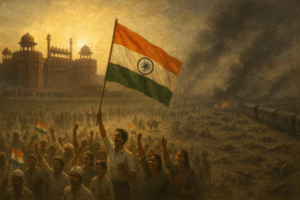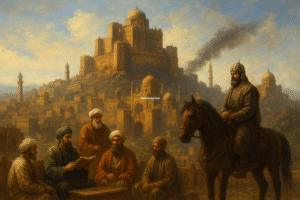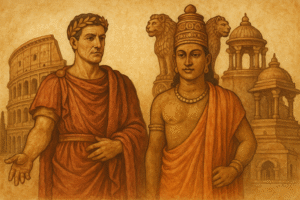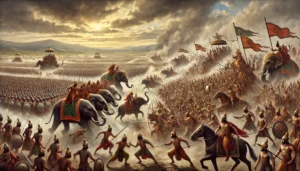The Rashtrakuta dynasty (8th–10th centuries CE), one of India’s most powerful and culturally influential empires, made remarkable contributions to art, architecture, and religion. Among their most enduring legacies is the Kailasa Temple at the Ellora Caves, a masterpiece of Indian rock-cut architecture. The temple and other caves at Ellora represent a fusion of religious traditions, artistic brilliance, and technological ingenuity, underscoring the Rashtrakutas’ role as patrons of culture and religion.
This article delves into the Rashtrakutas’ contributions to the Ellora Caves and examines the significance of these monuments in Indian history.
The Rashtrakuta Dynasty: An Overview
Origins and Expansion
The Rashtrakutas originally hailed from the Deccan region, establishing their capital at Manyakheta (in modern-day Karnataka). They emerged as a dominant power after overthrowing the Chalukyas in the 8th century CE. Under rulers like Dantidurga, Krishna I, and Amoghavarsha I, the Rashtrakutas expanded their empire across much of the Indian subcontinent, wielding influence from the Vindhyas to the far south.
Cultural Patrons
Known for their religious tolerance, the Rashtrakutas supported Hinduism, Buddhism, and Jainism. Their reign marked a golden age of cultural synthesis, fostering advancements in literature, philosophy, and architecture.
The Ellora Caves: A Cultural and Architectural Marvel
The Ellora Caves, a UNESCO World Heritage Site located in present-day Maharashtra, consist of 34 rock-cut temples and monasteries carved into the Charanandri hills. These caves represent three major religions—Hinduism, Buddhism, and Jainism—and were excavated between the 6th and 10th centuries CE. The Rashtrakutas, who ruled during the latter half of this period, played a pivotal role in their construction.
The Kailasa Temple: Jewel of the Ellora Caves
Commissioned by Krishna I
The crowning achievement of the Rashtrakutas at Ellora is the Kailasa Temple (Cave 16), commissioned by King Krishna I in the 8th century CE. Dedicated to Lord Shiva, this temple is the largest monolithic rock-cut structure in the world.
Architectural Features
- Rock-Cut Design: The Kailasa Temple was carved from a single basalt rock, starting from the top and working downward. This innovative technique required immense skill and precision.
- Structural Elements: The temple features a towering vimana (spire), intricately carved walls, and pillared halls. The central sanctum houses a Shiva linga, symbolizing the deity’s presence.
- Sculptural Brilliance: The temple is adorned with elaborate sculptures depicting scenes from Hindu mythology, including the Ramayana and Mahabharata. The central courtyard features life-sized carvings of elephants and lions, adding to the grandeur.
Engineering Marvel
The construction of the Kailasa Temple is estimated to have required the removal of 200,000 tons of rock, a feat achieved without modern tools or machinery. The temple’s design reflects advanced knowledge of engineering, mathematics, and art.
Religious Diversity at Ellora
The Rashtrakutas’ patronage extended beyond Hinduism, as evidenced by the Buddhist and Jain caves at Ellora.
Buddhist Caves (Caves 1–12)
The Buddhist caves, dating to the earlier phase of Ellora’s excavation, include monasteries and chaityas (prayer halls). They feature large halls with stupas, as well as sculptures of the Buddha and Bodhisattvas. Though constructed before the Rashtrakutas’ reign, these caves benefited from continued upkeep and additions under their rule.
Jain Caves (Caves 30–34)
The Jain caves, excavated during the later Rashtrakuta period, are smaller yet equally intricate. They reflect the ascetic ideals of Jainism, with detailed carvings of Tirthankaras (spiritual teachers) and symbolic motifs.
The Cultural Significance of the Rashtrakutas’ Contribution
Fusion of Art and Religion
The Rashtrakutas’ work at Ellora exemplifies the harmonious coexistence of multiple religious traditions. By commissioning temples for different faiths, the Rashtrakutas fostered an inclusive cultural environment, setting an example of religious tolerance.
Artistic Innovation
The Rashtrakutas pushed the boundaries of Indian art and architecture. The Kailasa Temple, in particular, stands as a testament to their vision and commitment to creating monuments of lasting significance.
Inspiration for Future Dynasties
The architectural achievements at Ellora influenced later dynasties like the Hoysalas and Cholas. The Rashtrakutas’ legacy can be seen in subsequent advancements in temple architecture across South India.
Decline and Legacy
The Rashtrakutas’ Decline
The Rashtrakutas’ power began to wane in the late 10th century CE, as they faced challenges from the Chalukyas of Kalyani and other regional powers. Despite their decline, their cultural contributions endured.
Ellora’s Enduring Appeal
Today, the Ellora Caves attract visitors and scholars from around the world, showcasing the Rashtrakutas’ genius. The Kailasa Temple remains a symbol of India’s architectural and spiritual heritage.
Legacy
The Rashtrakutas’ contributions to the Ellora Caves, particularly the construction of the Kailasa Temple, reflect their unparalleled vision and dedication to cultural and religious expression. By integrating artistic brilliance with religious devotion, the Rashtrakutas not only left a lasting architectural legacy but also underscored the importance of tolerance and innovation in Indian history. Their work continues to inspire awe and admiration, standing as a testament to the grandeur of medieval Indian civilization.






